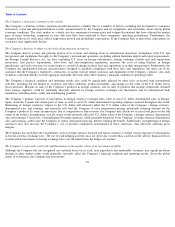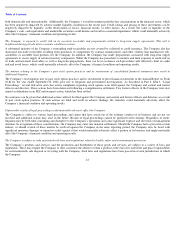Apple 2009 Annual Report Download - page 25
Download and view the complete annual report
Please find page 25 of the 2009 Apple annual report below. You can navigate through the pages in the report by either clicking on the pages listed below, or by using the keyword search tool below to find specific information within the annual report.
Table of Contents
The Company’s stock price continues to be volatile.
The Company’
s stock has at times experienced substantial price volatility due to a number of factors, including but not limited to variations
between its actual and anticipated financial results, announcements by the Company and its competitors, and uncertainty about current global
economic conditions. The stock market as a whole also has experienced extreme price and volume fluctuations that have affected the market
price of many technology companies in ways that may have been unrelated to these companies’
operating performance. Furthermore, the
Company believes its stock price reflects high future growth and profitability expectations. If the Company fails to meet these expectations its
stock price may significantly decline.
The Company’s business is subject to the risks of international operations.
The Company derives a large and growing portion of its revenue and earnings from its international operations. Compliance with U.S. and
foreign laws and regulations that apply to the Company’
s international operations, including without limitation import and export requirements,
the Foreign Corrupt Practices Act, tax laws (including U.S. taxes on foreign subsidiaries), foreign exchange controls and cash repatriation
restrictions, data privacy requirements, labor laws, and anti-
competition regulations, increases the costs of doing business in foreign
jurisdictions, and such costs may rise in the future as a result of changes in these laws and regulations or in their interpretation. Furthermore, the
Company has implemented policies and procedures designed to facilitate compliance with these laws and regulations, but there can be no
assurance that the Company’s employees, contractors, or agents will not violate such laws and regulations or the Company’
s policies. Any such
violations could individually or in the aggregate materially adversely affect the Company’s financial condition or operating results.
The Company’
s financial condition and operating results also could be significantly affected by other risks associated with international
activities, including but not limited to, economic and labor conditions, political instability, and changes in the value of the U.S. dollar versus
local currencies. Margins on sales of the Company’
s products in foreign countries, and on sales of products that include components obtained
from foreign suppliers, could be materially adversely affected by foreign currency exchange rate fluctuations and by international trade
regulations, including duties, tariffs and antidumping penalties.
The Company’s primary exposure to movements in foreign currency exchange rates relate to non-
U.S. dollar denominated sales in Europe,
Japan, Australia, Canada and certain parts of Asia, as well as non-
U.S. dollar denominated operating expenses incurred throughout the world.
Weakening of foreign currencies relative to the U.S. dollar will adversely affect the U.S. dollar value of the Company’s foreign currency-
denominated sales and earnings, and generally will lead the Company to raise international pricing, potentially reducing demand for the
Company’
s products. In some circumstances, due to competition or other reasons, the Company may decide not to raise local prices to the full
extent of the dollar’s strengthening, or at all, which would adversely affect the U.S. dollar value of the Company’
s foreign currency denominated
sales and earnings. Conversely, a strengthening of foreign currencies, while generally beneficial to the Company’s foreign currency-
denominated
sales and earnings, could cause the Company to reduce international pricing, thereby limiting the benefit. Additionally,
strengthening of foreign
currencies may also increase the Company’
s cost of product components denominated in those currencies, thus adversely affecting gross
margins.
The Company has used derivative instruments, such as foreign currency forward and option contracts, to hedge certain exposures to fluctuations
in foreign currency exchange rates. The use of such hedging activities may not offset any or more than a portion of the adverse financial effects
of unfavorable movements in foreign exchange rates over the limited time the hedges are in place.
The Company is exposed to credit risk and fluctuations in the market values of its investment portfolio.
Although the Company has not recognized any material losses on its cash, cash equivalents and marketable securities, any significant future
declines in their market values could materially adversely affect the Company’
s financial condition and operating results. Given the global
nature of its business, the Company has investments
22
























